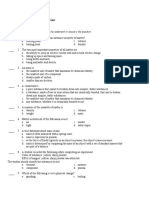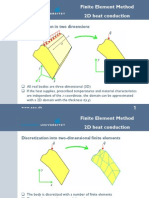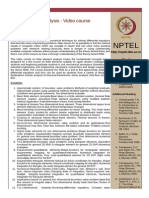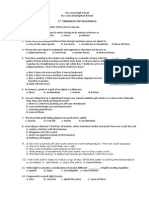0 ratings0% found this document useful (0 votes)
37 viewsOnline Test 3
Online Test 3
Uploaded by
sakthivel balamuruganThe document contains multiple choice questions and answers about finite element analysis concepts and ANSYS software. Specifically, it asks about element types, material properties, matrices used in analysis, types of strains, failure criteria, mesh refinement methods, loads, solution methods, and how ANSYS accepts section properties.
Copyright:
© All Rights Reserved
Available Formats
Download as DOCX, PDF, TXT or read online from Scribd
Online Test 3
Online Test 3
Uploaded by
sakthivel balamurugan0 ratings0% found this document useful (0 votes)
37 views2 pagesThe document contains multiple choice questions and answers about finite element analysis concepts and ANSYS software. Specifically, it asks about element types, material properties, matrices used in analysis, types of strains, failure criteria, mesh refinement methods, loads, solution methods, and how ANSYS accepts section properties.
Original Description:
ONLINE TEST 3
Original Title
ONLINE TEST 3
Copyright
© © All Rights Reserved
Available Formats
DOCX, PDF, TXT or read online from Scribd
Share this document
Did you find this document useful?
Is this content inappropriate?
The document contains multiple choice questions and answers about finite element analysis concepts and ANSYS software. Specifically, it asks about element types, material properties, matrices used in analysis, types of strains, failure criteria, mesh refinement methods, loads, solution methods, and how ANSYS accepts section properties.
Copyright:
© All Rights Reserved
Available Formats
Download as DOCX, PDF, TXT or read online from Scribd
Download as docx, pdf, or txt
0 ratings0% found this document useful (0 votes)
37 views2 pagesOnline Test 3
Online Test 3
Uploaded by
sakthivel balamuruganThe document contains multiple choice questions and answers about finite element analysis concepts and ANSYS software. Specifically, it asks about element types, material properties, matrices used in analysis, types of strains, failure criteria, mesh refinement methods, loads, solution methods, and how ANSYS accepts section properties.
Copyright:
© All Rights Reserved
Available Formats
Download as DOCX, PDF, TXT or read online from Scribd
Download as docx, pdf, or txt
You are on page 1of 2
These are the elements having no internal nodes
A. Lagrange elements
B. Serendipity elements
C. Symmetric
D. Unsymmetrical element
Answer: B
These are the elements having internal nodes which can be condensed out at the element level
before assembling.
A. Lagrange elements
B. Serendipity elements
C. Symmetric
D. Unsymmetrical element
Answer: A
A material with same mechanical properties in three mutually perpendicular directions.
A. Orthotropic material
B. Non- linearity material
C. Smart material
D. Isotropic material
Answer: D
The matrix, which relates force to displacement in stress problems and applied heat to temperature
problems.
A. Stiffness Matrix
B. Material property matrix
C. Strain energy matrix
D. Inverting a matrix
Answer: A
The strain produced in an element due to a change in temperature.
A. Lateral strain
B. Shear strain
C. Heat flux
D. Thermal strain
Answer: D
A method of predicting when a material can be considered to have failed.
A. FMEA method
B. DFMA method
C. Von-Mises failure criterion
D. Hybrid method
Answer: C
As a default option, mesh is refined in ANSYS using
A. g-method
B. h-method
C. p-method
D. r-method
Answer: B
Loads command in ANSYS includes
A. Loads only
B. Loads & stresses
C. Loads or displacements
D. Loads & displacements
Answer: D
Most FEM software use
A. Displacement method
B. Force method
C. Stress method
D. Hybrid method
Answer: A
ANSYS accepts section properties set based on______.
A. Element size
B. Element type
C. Type of load
D. Type of material
Answer: B
You might also like
- Chemistry Midterm Exam ReviewDocument31 pagesChemistry Midterm Exam ReviewKenny Chang80% (5)
- 2-FEA MCQ - 2 One Marks PDFDocument5 pages2-FEA MCQ - 2 One Marks PDFbalajimeie70% (23)
- Exam Materials ScienceDocument10 pagesExam Materials ScienceChimzoe CatalanNo ratings yet
- Fea Assignment - IDocument13 pagesFea Assignment - Isakthivel balamuruganNo ratings yet
- Fea Online Test 3Document2 pagesFea Online Test 3sakthivel balamuruganNo ratings yet
- Fea Online Test 3Document2 pagesFea Online Test 3sakthivel balamuruganNo ratings yet
- Fem Lab Quiz 2Document4 pagesFem Lab Quiz 2srinis4777-1No ratings yet
- Objective Type Questions With Answer Key Finite Element AnalysisDocument5 pagesObjective Type Questions With Answer Key Finite Element Analysissakthivel balamurugan100% (1)
- Q.no 1. For Thermal Analysis, The Field Variable IsDocument128 pagesQ.no 1. For Thermal Analysis, The Field Variable IsAMOL JAGTAPNo ratings yet
- Introduction To Finite Element MethodDocument16 pagesIntroduction To Finite Element MethodmutthudarurNo ratings yet
- Introduction To Finite Element MethodDocument16 pagesIntroduction To Finite Element Methodshrikant belsareNo ratings yet
- Introduction To Finite Element Method: Mathematic ModelDocument16 pagesIntroduction To Finite Element Method: Mathematic ModelAaditya RoyNo ratings yet
- Engineering MaterialsDocument24 pagesEngineering MaterialsJo CesNo ratings yet
- Abs Mpi TestDocument7 pagesAbs Mpi TestSani TipareNo ratings yet
- Introduction To Finite Element Method: Mathematic ModelDocument16 pagesIntroduction To Finite Element Method: Mathematic ModelSanthosh Lingappa100% (1)
- Unit 3 One Marks QuestionsDocument6 pagesUnit 3 One Marks QuestionsRahulNo ratings yet
- Thermal Engineering 1 Mcqs (Set-1) : Chapter: Heat TransferDocument6 pagesThermal Engineering 1 Mcqs (Set-1) : Chapter: Heat TransferTete BernnabeeNo ratings yet
- Composite Materials and Structures: Unit-1Document8 pagesComposite Materials and Structures: Unit-1Harish Mathiazhahan100% (1)
- Multi Choice Questions On 303148: Utilization of Electrical EnergyDocument26 pagesMulti Choice Questions On 303148: Utilization of Electrical EnergyTejas PatilNo ratings yet
- Selected Answer: C. Answers: A. B. C. DDocument20 pagesSelected Answer: C. Answers: A. B. C. Dpampampam ramramNo ratings yet
- Physics of Solids' MCQsDocument9 pagesPhysics of Solids' MCQsMuhammad Rehan QureshiNo ratings yet
- FEM Method in 2D Heat Conduction PDFDocument52 pagesFEM Method in 2D Heat Conduction PDFAhmadreza AminianNo ratings yet
- Redbook 6Document113 pagesRedbook 6xjaemadridNo ratings yet
- Engineering Materials ReviewerDocument23 pagesEngineering Materials ReviewerMuhammad Abundi Malik100% (6)
- Institute of Technology and Sciences: Department of Mechanical Engineering Class: III Year MechanicalDocument2 pagesInstitute of Technology and Sciences: Department of Mechanical Engineering Class: III Year Mechanicalvasanth09ajayNo ratings yet
- MCQs of CMPDocument4 pagesMCQs of CMPHoomi ShbNo ratings yet
- Introduction To Finite Element MethodDocument16 pagesIntroduction To Finite Element MethodSri Rama ChandNo ratings yet
- PHY 206 Thermal Physics Multiple Choice QuestionsDocument55 pagesPHY 206 Thermal Physics Multiple Choice QuestionsOlamide Ajasa0% (1)
- Failure Analysis and Design TopicsDocument2 pagesFailure Analysis and Design TopicsYash SaksenaNo ratings yet
- 200Document10 pages200joshhyyygabNo ratings yet
- GEAS Engineering MaterialsDocument66 pagesGEAS Engineering MaterialsVictoriaNo ratings yet
- Finite Element Analysis MCQDocument13 pagesFinite Element Analysis MCQShiva KarthikeyanNo ratings yet
- MIT3 044S13 2013exam1Document8 pagesMIT3 044S13 2013exam1Dak KaizNo ratings yet
- Department of Materials Science and Engineering Massachusetts Institute of Technology 3.044 Materials Processing - Spring 2013 Problem Set 2Document3 pagesDepartment of Materials Science and Engineering Massachusetts Institute of Technology 3.044 Materials Processing - Spring 2013 Problem Set 2Dak KaizNo ratings yet
- Nptel: Finite Element Analysis - Video CourseDocument3 pagesNptel: Finite Element Analysis - Video CourseSushil MundelNo ratings yet
- A. Atoms: Engineering MaterialsDocument36 pagesA. Atoms: Engineering MaterialsAmpolNo ratings yet
- Periodical Test in Science 8Document3 pagesPeriodical Test in Science 8Eileen Joy Noceda88% (195)
- Change Length) Length Force Area Length Change LengthDocument6 pagesChange Length) Length Force Area Length Change LengthSYBRELLE CRUZNo ratings yet
- FE Mechanical Exam Computer Based Test CoverageDocument4 pagesFE Mechanical Exam Computer Based Test Coverageaoeusnthid0% (3)
- Instrumentation MCQ'sDocument32 pagesInstrumentation MCQ'sAmmarAbdullah89% (9)
- Dome Unit-1 Q&A 100Document17 pagesDome Unit-1 Q&A 100VARUN BABUNELSONNo ratings yet
- Assignment05 SolutionDocument2 pagesAssignment05 Solutionkumaresan cNo ratings yet
- MCQ SDocument31 pagesMCQ SkaranipgrNo ratings yet
- MCQ in Electricity and Magnetism Fundamentals Part 5 ECE Board ExamDocument18 pagesMCQ in Electricity and Magnetism Fundamentals Part 5 ECE Board ExamJirah GicangaoNo ratings yet
- Question For Basic by GJDocument53 pagesQuestion For Basic by GJravindra_jivani100% (1)
- Thermal Engineering MCQDocument41 pagesThermal Engineering MCQ222Gaurav AherNo ratings yet
- Backwards Differencing DirichletDocument3 pagesBackwards Differencing DirichlethlvijaykumarNo ratings yet
- Exam Draft 4Document1 pageExam Draft 4kayem14No ratings yet
- FE Mec CBT Specs PDFDocument4 pagesFE Mec CBT Specs PDFVictor VerdanNo ratings yet
- PT - Science 8 - Q1Document3 pagesPT - Science 8 - Q1C Aina Myles CabatbatNo ratings yet
- Finite Element MethodDocument65 pagesFinite Element MethodsanthiamuthaNo ratings yet
- Aces Esas 4Document6 pagesAces Esas 4Jay TabagoNo ratings yet
- Finite Element Analysis: Term TestDocument2 pagesFinite Element Analysis: Term TestAdil KhawajaNo ratings yet
- Analyze The Rectangular Plate With Hole Under Axial Load As Shown in Figure, Find The NodalDocument4 pagesAnalyze The Rectangular Plate With Hole Under Axial Load As Shown in Figure, Find The Nodalsakthivel balamuruganNo ratings yet
- Nandha Engineering College, Erode - 52Document4 pagesNandha Engineering College, Erode - 52sakthivel balamuruganNo ratings yet
- S. No. Reg. No. Name Section Question NoDocument1 pageS. No. Reg. No. Name Section Question Nosakthivel balamuruganNo ratings yet
- S. No. Reg. No. Name Section Question NoDocument1 pageS. No. Reg. No. Name Section Question Nosakthivel balamuruganNo ratings yet
- Nandha Engineering College, Erode-52 (15me603 - Finite Element AnalysisDocument3 pagesNandha Engineering College, Erode-52 (15me603 - Finite Element Analysissakthivel balamuruganNo ratings yet
- Nandha Engineering College, Erode-52 (: 15ME603 - Finite Element AnalysisDocument4 pagesNandha Engineering College, Erode-52 (: 15ME603 - Finite Element Analysissakthivel balamuruganNo ratings yet
- ME402 FEA Objective Questions-IIDocument5 pagesME402 FEA Objective Questions-IIsakthivel balamuruganNo ratings yet
- Nandha Engineering College, Erode-52 (Autonomous) 15me603 - Finite Element Analysis Assignment - I Part-ADocument2 pagesNandha Engineering College, Erode-52 (Autonomous) 15me603 - Finite Element Analysis Assignment - I Part-Asakthivel balamuruganNo ratings yet
- Fea 15me603Document2 pagesFea 15me603sakthivel balamuruganNo ratings yet
- Fem Objective QuestionsDocument12 pagesFem Objective Questionssakthivel balamuruganNo ratings yet
- MtsDocument4 pagesMtssakthivel balamuruganNo ratings yet
































































